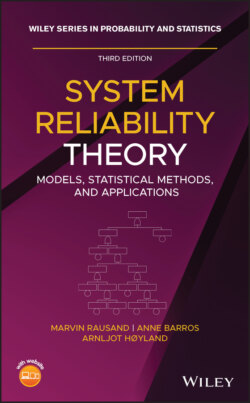Читать книгу System Reliability Theory - Marvin Rausand - Страница 19
1.2.1 Related Applications
ОглавлениеReliability considerations and reliability studies are important inputs to a number of related applications. Several of these applications have adopted the basic terminology from reliability. Among the relevant applications are:
Risk analysis. The main steps of a quantitative risk analysis (QRA) are: (i) identification and description of potential initiating events that may lead to unwanted consequences, (ii) identification of the main causes of each initiating event and quantification of the frequency of the initiating events, and (iii) identification of the potential consequences of the initiating events and quantification of the probabilities of each consequence. The three steps are shown in the bow‐tie model in Figure 1.3, where the main methods are indicated. The methods that are covered in this book are marked with an .
Maintenance planning. Maintenance and reliability are closely interlinked. High‐quality maintenance improves the operational reliability and high reliability gives few failures and low maintenance cost. The close link is also visible in the popular approach reliability‐centered maintenance (RCM), which is discussed in Chapter 9.
Quality. Quality management is increasingly focused, stimulated by the ISO 9000 series of standards. The concepts of quality and reliability are closely connected. Reliability may in some respects be considered to be a quality characteristic.
Life cycle costing. The life cycle cost (LCC) may be split into three types: (i) capital expenditure (CAPEX), (ii) operational expenditure (OPEX), and (iii) risk expenditure (RISKEX). The main links to reliability are with types (ii) and (iii). The OPEX is influenced by how regular the function/service is and the cost of maintenance. The RISKEX covers the cost related to accidents, system failures, and insurance. LCC is also called total ownership cost.
Production assurance. Failures in a production system lead to downtime and reduced production. To assure a regular production, the production system must have a high reliability. Production assurance is treated in the international standard ISO 20815 and discussed in Chapter 6.
Warranty planning. A warranty is a formal commitment to deliver reliable items. If failures and malfunctions are detected during a specified warranty period, the supplier has to repair and/or compensate the failure. Unreliable items may incur a high cost for the supplier.
Systems engineering. Reliability is one of the most important quality attributes of many technical systems. Reliability assurance is therefore an important topic during the systems engineering process. This is especially the case within the nuclear power, the aviation, the aerospace, the car, and the process industries.
Environmental protection. Reliability studies are used to improve the design and operational availability of many types of environmental protection systems. Many industries have realized that a main part of the pollution from their plants is caused by production irregularities and that consequently the reliability of the plant is an important factor in order to reduce pollution. Environmental risk analyses are carried out according to the procedure shown in Figure 1.3.
Technology qualification. Many customers require the producer of technical items to verify that the item satisfies the agreed requirements. The verification is carried out by following a technology qualification program (TQP) based on analysis and testing. This is especially the case within the aerospace, defense, and petroleum industries (e.g. see DNV‐RP‐A203 2011).
Applications related to reliability are illustrated in Figure 1.4.
Figure 1.3 Main steps of risk analysis, with main methods. The methods covered in this book are marked with .
Figure 1.4 Reliability as basis of other applications.
